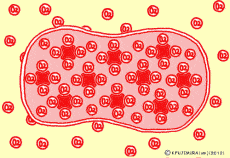[023] Eerythrocyte and hemoglobin (GB#104D02) | 基礎医学教育研究会(KIKKEN)Lab

● Red blood cells can live without oxygen
Red blood cells occupy 99% of the cells in the blood and do an important work carrying oxygen ( O2 ). It is because the cells in the body need oxygen. The erythrocyte seems to be a beanbag that azuki beans packed moderately. As for contents, there is nothing with little shape other than protein called hemoglobin equivalent to red beans. Although it is famous that there are no cell nuclei even though it is a cell, it has neither an endoplasmic reticulum nor a mitochondrial. To my surprise, red blood cells suck oxygen into hemoglobin completely and hold a large amount of oxygen, they do not breathe oxygen at all.
—
Contents
There is no problem even if there is no nucleus
The erythrocytes are approximately 8 μm in diameter and approximately 2 μm in thickness, shaped like a round rice cake that is dented in the middle. In the capillary, though it is thinner than this diameter, the erythrocytes easily pass through while deforming sharply.
Because it is a cell without nucleus, protein can not be made, but will hemoglobin come from? In fact, hemoglobin is synthesized in the cell at the same time that this cell is made in the bone marrow. When in the bone marrow, this cell has both nucleus, ribosome and mitochondria. Therefore, protein synthesis is possible. Just before and as soon as it enters the blood vessels as red blood cells, the devices in these cells are thrown away and reborn into a bag with nearly a large amount of hemoglobin. It can be said to be the ultimate choice for giving top priority to the transportation of oxygen required in the periphery.
This cell does not breathe oxygen because there is no mitochondria. However, since the cell death occurs unless the cell membrane ion pump is turned, the minimum ATP is covered by the glycolysis system. So this cell keeps working alive for 120 days, even one-third of the year.
※ Because there is only glycolysis system, erythrocytes can not use other than glucose as an energy source.
● One hemoglobin carries four oxygen molecules
Hemoglobin is composed of four components (subunits) having a molecular weight of approximately 16000 and becomes a large protein with a total molecular weight of approximately 64000. Hemoglobin carries only 4 molecules of oxygen, although it is so big. It has a container called “heme” that contains one oxygen molecule ( O2 ) in one subunit molecule. It seems that it is important that a part of this container is an atom of iron. Most people will know that iron is easy to stick to oxygen. Iron rust is due to oxygen. Each hemoglobin subunit is buried with heme containing one iron atom (Fe), and one oxygen molecule is captured at the iron atom. This reaction seems to be different from the reaction (oxidation) of iron rust, but the iron’s ability to attract oxygen is well utilized. When oxygen combines, the structure of the hem changes (because it reflects only red light) and it looks bright red. Heme molecules that have lost oxygen also return to their original state and appear reddish. Even so, with only 4 oxygen molecules per gigantic hemoglobin, is that okay? It seems that everyone was wondering at a moment.
● Hemoglobin carries 80 times the oxygen
Oxygen will also dissolve in water which accounts for 90% of the plasma. Depending on oxygen partial pressure and temperature, at 100 mmHg which is oxygen partial pressure in the alveolar, approximately 3 ml of oxygen dissolves in 1 liter of water at 37 °C. It is 0.00012 mol, approximately 7.2 × 1019 molecule. Meanwhile, one erythrocyte contains approximately 280 million hemoglobin (2.8 × 108). Therefore, up to 2.8 × 108 × 4 oxygen molecules are absorbed in one erythrocyte. One liter of blood contains approximately 5 trillion erythrocytes (5 × 1012). Therefore, oxygen of up to 2.8 × 108 × 4 × 5 × 1012 = 56 × 1020 =560 × 1019 molecules is absorbed by hemoglobin in 1 liter of blood.
It is 560 ÷ 7.2 = 77.8 times as compared with 1 liter of plasma alone, which is about 80 times the difference. (Normally it is said that it carries 70 times more oxygen, so it seems that the calculation is generally suitable.) So 4 oxygens in one molecule of hemoglobin has utter efficacy at all.
* The number of erythrocytes is standard 4.5 million to 5.5 million per 1 microliter of blood.
· Since the hemoglobin amount per erythrocyte is approximately 30 pg (30 × 10-12 g) and the molecular weight of hemoglobin is 64000, the number of molecules of hemoglobin per erythrocyte is 30 × 10-12 × 6.02 × 1023 / 64000 = 180 / 6.4 × 107 = 2.8 × 108.
● Red blood cells shuttle flights between the alveoli and the periphery
Hemoglobin receives oxygen in the alveoli. Since the oxygen concentration of the alveoli (oxygen partial pressure as a physiological index) is sufficiently high (100 mmHg), most hemoglobin of most red blood cells fills with oxygen. While returning to the heart and flowing through the arteries that send fresh blood into the body, gas such as oxygen can hardly escape through the walls of thick blood vessels, so it is distributed in blood vessels that branch out more and more as they are. As soon as the blood vessel turns into a capillary, the wall of the blood vessel becomes thinner and gas entrance and exit becomes free, the oxygen partial pressure of the surrounding is lowered down to 40 mmHg or less and oxygen drops automatically from hemoglobin, It scatters in tissues waiting for oxygen. The surprising thing is that he carries oxygen to the periphery is work of hemoglobin, but if it is around 40 mmHg, more than 50 % hemoglobin will bring back oxygen as it is. Lower oxygen partial pressure in peripheral tissues will cause more oxygen to dissociate accordingly, but hemoglobin seems quite stingy that oxygen is placed only as much as needed.
⇒Oxygen dissociation curvereference
● Blood is a connective tissue
It is common sense that hemoglobin carries oxygen. However, it is not well known that having an important role of carrying carbon dioxide ( CO2 ) to the alveoli, even if returning from the periphery, unless you study. Besides that, hormones and anions and heat and blood carry various things among the periphery. It is slightly surprising to amateur that blood which is always flowing is classified as “connective tissue” in an anatomical textbook the same as ligaments and tendons. However, there is no doubt that it is a fine connective tissue in that it is functionally connected by logistics to every corner of the body.
People who want to see the three-dimensional structure of hemoglobin molecules ⇒ Molecule of the Month
○Related articles
◆[029] Oxyhemoglobin dissociation curve ![]()
◆[050] Cellular respiration ![]()
◆[047] Glycolysis ![]()
◆[016] Blood circulation ![]()
◆[010] Alveolar ventilation and dead space ![]()
◆[001] Heartbeat pumping ![]()
◆[004] Cation and anion, attraction and repulsion ![]()
◆[011] Body acid-base reaction and carbon dioxide gas ![]()
○ Referenced books
・Essential細胞生物学〈DVD付〉原書第3版,南江堂
・細胞の分子生物学, ニュートンプレス; 第5版 (2010/01)
・臓単―ギリシャ語・ラテン語 (語源から覚える解剖学英単語集 (内臓編))
・カラー図解 人体の正常構造と機能 全10巻縮刷版,坂井 建雄,日本医事新報社
・人体機能生理学,杉 晴夫,南江堂
・細胞の分子生物学, ニュートンプレス; 第5版 (2010/01)
・トートラ人体解剖生理学 原書8版,丸善
・イラスト解剖学,松村 讓兒,中外医学社
・柔道整復学校協会編「生理学」,南江堂
・東洋療法学校協会編「生理学」,医歯薬出版株式会社
rev.20160709, rev.20170211, rev.20170505, rev.20170522, rev.20180503.
KISO-IGAKU-KYOIKU-KENKYUKAI(KIKKEN)







